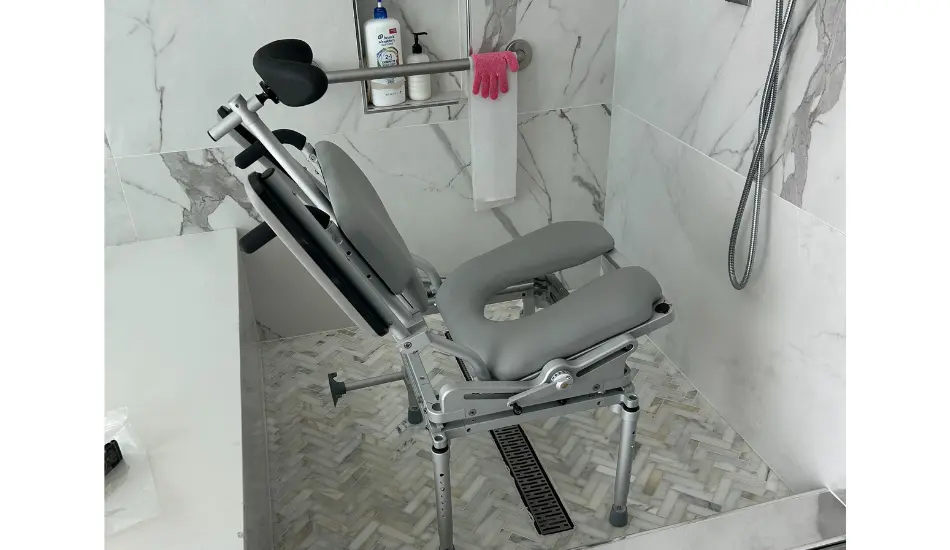When you or someone very close to you is struggling with limited mobility and finding it challenging to take a safe and comfortable shower, you look for reliable support. Being fearful of getting inside and coming out of the tub or feeling risky during a simple bath is quite normal. In such cases, a bath transfer chair can be the right solution.
But there are lots of types and options available with different features. So, which one is the right one for you? We understand how important choosing the perfect bath transfer chair is- one that will meet your needs. That’s why we’re here with our ultimate guide, just for you.
From safety features and adjustability options all the way down to seat width and weight capacity, there are many factors that need careful consideration. We’re here to break it down in simple terms so you can make an informed decision without any hassle.
What Is a Bath Transfer Chair?
A bath transfer chair is also known as a tub transfer bench. It’s a remarkable assistive device that makes getting in and out of a bathtub secure and more comfortable for people who have trouble moving around.
With a bath transfer chair, you can comfortably remain seated while transferring in and out of the shower or bathtub. It typically has two legs placed inside the tub and two legs on the bathroom floor.
There’s no need to climb in and out by straddling over the bathtub wall. So, bathing becomes safer and more accessible. Also, the handling controls come at your fingertips, so you don’t even need to reach for the wall-mounted fixtures.
These specially designed chairs are perfect for individuals who may struggle with weakness, fatigue, or poor balance. Two useful suggestions you can follow while using a transfer bench or chair:
- Sit on the chair facing toward the shower.
- Use a handheld showerhead that allows you to control water direction.

Features to Consider When Choosing the Perfect Bath Transfer Chair
A bath transfer chair can significantly improve the bathing experience of seniors or anyone who struggles with mobility. But not just any transfer bench can do the trick. It has to be perfect in every aspect for the user. So, check for the following features in your transfer chair to achieve that accuracy:
-
Overall Size
You need to consider the overall size of your bathroom space and that of a bath transfer chair. The goal is to choose a bench that fits perfectly in your bathroom and supports your weight and height.
To find the right size for your room:
- Measure the tub’s width and the space on the floor around it.
- Make sure there is enough space for the transfer bench to go all the way across and for you or anyone else to safely stand or sit down.
- Choose a seat width that lets you use it comfortably without feeling cramped in your bathroom.
If you use a wheelchair along with the transfer chair, you should consider its width and depth. There might be a need for another person standing inside the space for additional support. Factor this in during the measurement, too. Must keep in mind that there are some transfer benches that may not work with tub walls higher than 18 inches.
-
Weight Capacity
Always check the product’s weight limit before buying it to make sure it can carry your weight and some more. On heavy-duty transfer benches, you can put up to 500 pounds. However, most standard benches can only hold 250 to 300 pounds.
The weight range of bariatric products starts from 400 pounds. However, there is no official “bariatric weight.” It depends on the item and the user. Just to be safe, people who weigh more than 250 pounds should buy a bariatric tub bench.
-
Seat Size
Accurately comprehending the bench’s seat size will make sure you can get on and off safely and sit comfortably. To find the right seat width for you, sit down on a flat surface and measure the width of your backside. For safety reasons, the seat should be at least 6 inches wider than this measurement.
Simply measure the distance from your backside to the back of your knees to find the right seat depth. It is safe and comfortable to sit on a chair that is an inch or two deeper than this dimension.
A seat depth of 19 inches, a height of 21 inches, and a width of 26 inches are considered ideal. But you should get your own preferred measurement.
-
Materials
When the material of the bench is your concern, focus on the durability and strength of the product. The transfer chair will be used in wet places, so the materials need to be resistant to water, rust, and wear over time.
The frames are usually made of either aluminum or plastic. Aluminum products cost more than plastic because they offer stability and longevity. The arm rails or handles of the transfer chair are also very important features. Make sure they have foam padding to keep your hands comfortable and ensure a good grip. Slippery handles can be dangerous, so choose ones that won’t slip.
Also, pay attention to the material of the seats. A rubber seat with holes is best because it keeps water from building up and makes sure it drains properly.
-
Padded vs. Unpadded
Most tub benches have two types of surfaces: padded plastic and unpadded plastic. In general, padded benches are more comfortable to sit on. This is especially true if you are very thin (and bony) or like to take long showers. But they are a bit more costly than equivalent unpadded ones.
Usually, benches without padding are cheaper. However, they are a little easier to “scoot” from one end to the other. That’s because the hard surface is smoother and easier to push down on than padded tub benches.
-
Back vs. No Back
The backrest on a transfer chair is optional. Even though a backrest can get in the way and slow down transfers, it is best to have one on your chair.
The price difference between a transfer chair with and without a back is not much. Besides, the backrests make the chair a safe place to rest. This can make bathing much more comfortable and lower the risk of falling.
-
Height Flexibility
As far as height goes, you should look for a transfer bench that can be set in at least four different levels. That means choosing the option with an adjustable height feature even though it costs some more. You can then adjust the height and comfort of your seat to your liking.
When you buy one, make sure it has an easy-to-reach lever that locks securely in place when it is tightened. Check to see if the legs can be adjusted to the height you want without any other changes having to be made.
Video Credit: Nuprodx, Inc.
Reasons Why People Use Bath Transfer Chair
There are several reasons why people choose to buy a bath transfer chair. For many, the decision comes after experiencing a stroke or hip fracture. Those individuals require at least some sturdy support in the bathroom. Some people proactively purchase one so they can prevent any potential injuries caused by difficulty entering and exiting the tub.
We can say the main purpose of a bath transfer chair is injury prevention, particularly fractures or head injuries that can occur during transfers in the bathroom. These tasks seem rather simple for those without mobility challenges. However, they become significantly more difficult when dealing with disabilities or declining health conditions.
FAQ
What is the Difference Between Transfer Chairs and Shower Chairs?
You may think they are the same, but that’s not actually true. The key variation lies in their placement. A transfer bench is designed to straddle the tub wall. In the meantime, a shower chair sits inside the shower or bathtub.
Shower chairs take up little space in small bathrooms. So, if you need more space for yourself or your caregiver, this is a great choice. However, they don’t assist with entering and exiting the tub like transfer benches do.
For individuals who need additional support when maneuvering into and out of the tub to prevent slips and falls, a transfer bench is recommended. Also, note that using a shower chair may ask for supplementary safety measures. Options like grab bars or safety rails will be needed for added stability when transitioning.
Can I Use a Shower Transfer Chair in The Tub?
Yes, you can use a shower transfer chair in the shower or tub. But remember to adjust the chair’s legs so that they are perfectly level on the floor and securely fastened with mounting screws or non-slip pads. Picking a chair with a textured surface and an anti-slip base will also help you stay in place.
Can All Shower Transfer Chairs Fit in My Bathroom?
Regular shower transfer chairs will fit in most bathrooms, but you need to measure your space first. On average, typical chairs are 16 to 22 inches wide and can be adjusted for length and height.
How Much Do Transfer Benches Cost?
The price of transfer chairs may vary based on the brand, features, and quality. On average, you can find choices between $295 to $5995. Before choosing one to buy, you should think about your budget and put safety and comfort first.
Conclusion
You can get the most out of a bath transfer chair if you choose the right one- having reliable support during bathing and not being afraid of falling and getting hurt. But your personal preferences will significantly impact this selection. The height and weight capacity of the chair needs to match your requirements.
Besides, whether you want a padded one, an unpadded one, or one with a backrest, you need to decide beforehand. Not being knowledgeable about such features may put you in a state of bother in the long run.
But if you want a reliable option without wandering here and there, Call Before You Fall can help. Our bath transfer chair fits into most bathtubs and showers and can go over standard and taller ADA-compliant toilets. Contact us today for the transfer chair that showcases quality, durability, and performance!




